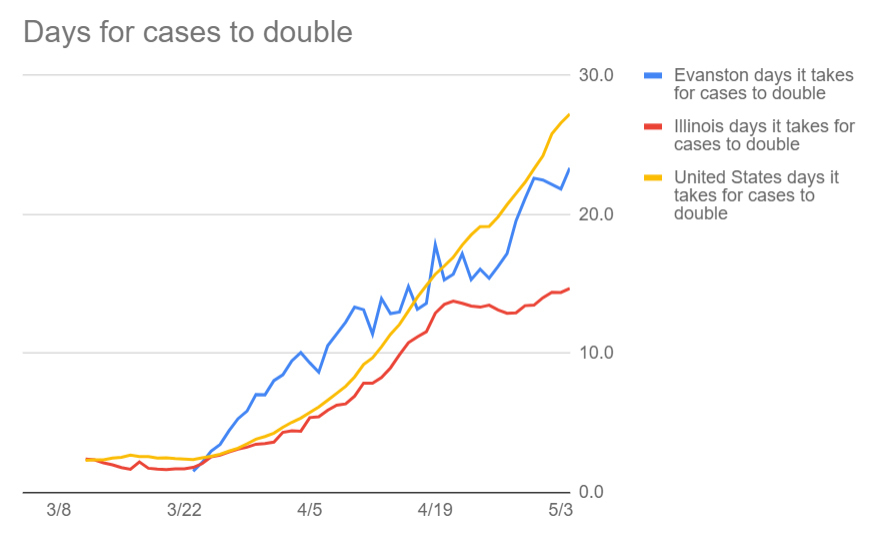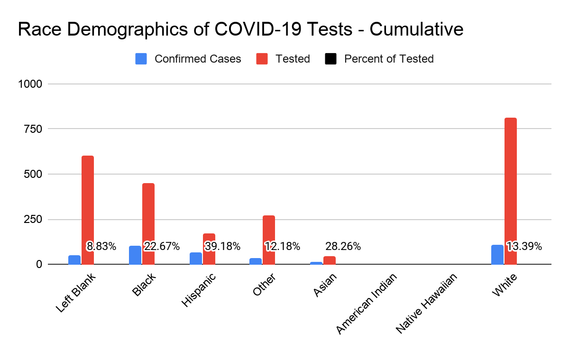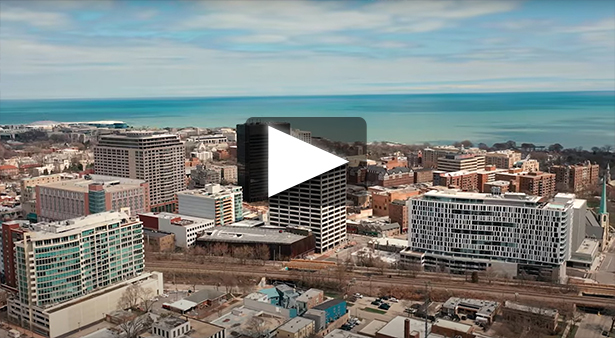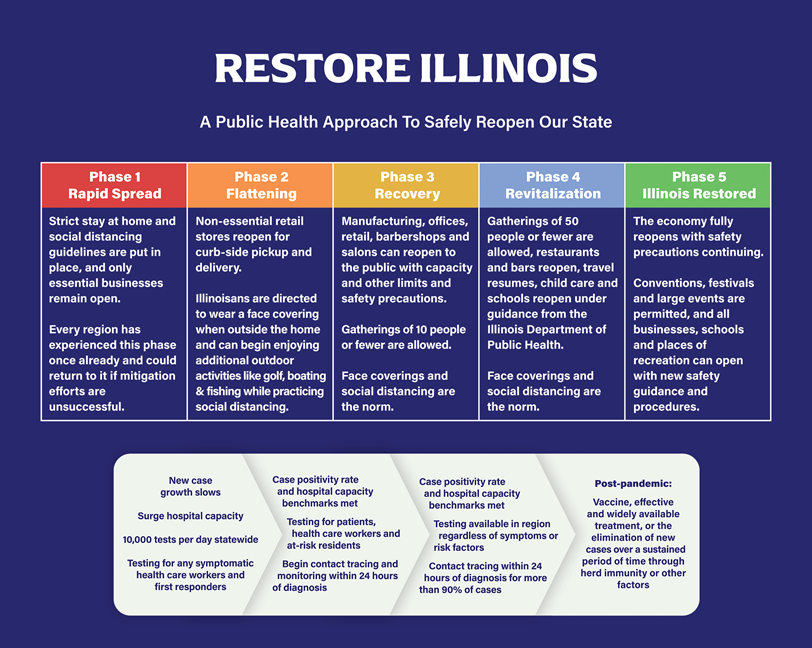
Tuesday, May 5, 2020 | View in browser
Let’s not play ‘Chutes and Ladders’ with COVID-19
If you’ve ever played the board game, Chutes and Ladders, you know how it feels to make progress towards the finish, only to land on a chute that takes you back to the start.
COVID-19 has its own “chutes and ladders.” The progress we’ve all made by climbing ladders—like staying at home, practicing physical distancing, wearing face coverings in public, not leaving our home when we are sick, and washing our hands frequently—can quickly be erased if our collective efforts lapse.
Unlike Chutes and Ladders, where progress is determined by the roll of a dice, our steps forward in slowing the spread of COVID-19 in Evanston and Illinois aren’t left up to chance. They are fact-based and data-driven. Today, I want to give you a sense of where we stand as a community based on the Evanston-specific data. On some metrics, we’re doing well. On others, I’m concerned. The bottom line: All of us must stay the course to avoid re-starting this painful process.
First, the good news
We are slowing the spread.
At the outset, the concern among epidemiologists was the exponential growth of infections. It was that concern that led state governments to take drastic actions to “flatten the curve.” By all accounts, we are flattening the curve around the United States, in Illinois, and in Evanston. One measure of flattening the curve is increasing the number of days it takes for coronavirus cases to double. As the chart below shows, a month ago infections in Evanston were doubling about every five days. Today, it takes nearly three weeks for infections to double, a week longer than the doubling rate in Illinois. A higher number shows that we're making progress.

In this chart, a higher number is good. It shows that the number of days it takes for cases to double is increasing.

The number of Evanstonians testing positive for COVID-19 is lower than other Illinois communities.
Since April 9, 2,411 Evanstonians have been tested for COVID-19. Approximately 16% have tested positive. This “positivity rate” is significantly less than the 25-30% rate exhibited in Chicago and overall in the NorthShore University HealthSystem. This is positive news for Evanston. As more testing becomes available, experts anticipate the positivity rate will decrease.
Now, for the concerning news
COVID-19 hospital admissions continue to increase.
As the chart below shows, COVID-19 hospital admissions at AMITA St. Francis and NorthShore University HealthSystem continued to increase over the last month. While additional hospital beds and ICU units remain available, this rise in hospital admissions is a concern.

NorthShore and AMITA St. Francis COVID-19 hospitalizations as of May 4. (Click to enlarge.)

Sadly, as of today, 11 Evanston residents, including seven at Long Term Care Facilities, have died as a result of COVID-19.
Confirmed cases continue to increase.
While we have slowed the spread, the seven-day moving average continues to increase. Over the last month, we have seen our seven-day moving average go from 5 confirmed cases a day to over 10. Our goal is to see confirmed cases plateau and eventually decline, allowing our health care system to return to standard care instead of crisis care.

Confirmed daily COVID-19 cases in Evanston as of May 4. (Click to enlarge.)

25-50% of our new confirmed cases are at Long-Term Care Facilities (LTCF).
As shown in the graph above, from April 28 to May 4, about one-third of our new confirmed cases have occurred at congregate senior living facilities. This is why the Illinois Department of Public Health and the City’s Health and Human Services Department’s number one objective is supporting our senior living communities with testing, personal protective equipment (PPE), and health care resources. The data also shows that two-thirds of the confirmed cases in the last week occurred outside of congregate living centers, indicating that there is community spread.
Racial disparities exist in Evanston.
The racial disparities seen in Chicago and across the country are evident in Evanston as well. The IDPH has released data by zip code, and the graph below depicts what is happening in Evanston.
As the graph shows, community members of color have been disproportionately impacted by COVID-19. Among Hispanic residents, 39 percent of those tested for COVID-19 have tested positive. Among Black residents, nearly 23 percent of those tested have tested positive. For white residents, the test positivity rate is approximately 13 percent.
As a State and a City, we are taking action to improve our messaging and increase testing in communities of color.

Race demographics of COVID-19 tests as of May 4.
So, what does all this data mean?
It’s a mixed bag. We would hope to see our cases flattening or declining, but they are still slightly increasing based on the 7-day moving average. This implies that despite the efforts we're all undertaking, community spread continues. The takeaways:
- We must all continue to be vigilant about staying at home, even as the weather warms. When we have to leave for an essential function, we must practice strict physical distancing, wear a face covering, and always practice good hygiene.
- Our collective efforts are paying off. Evanston is slowing the spread and doing so at a rate greater than both Illinois and our neighbor, Chicago. We should take this as a sign that, although painful, our efforts are saving lives and producing positive results for our community—even if that progress isn’t as rapid as we’d like it to be.
None of us want our hard-earned progress to go down the chute. No one wants to start over. This is too painful. As difficult as these trying times are, we must stay the course, we must continue to support one another, and we must each continue to do our part to flatten the curve so that we can reopen our community and our state. Together, we will get to the finish.
Be well, and thank you for your continued efforts to slow the spread and save lives.
Sincerely,

Stephen H. Hagerty
Mayor, City of Evanston
shagerty@cityofevanston.org

Video: Evanston Loves
The progress we've collectively made in slowing the spread of COVID-19 would not be possible without the love and support we've shown one another during this trying time. Downtown Evanston and SparkRaw media created a video showcasing our community's strength and spirit.

Governor Pritzker Announces 'Restore Illinois' Framework
Earlier today, Governor J.B. Pritzker announced Restore Illinois, a five-phase plan focused on saving lives, livelihood, and safely reopening Illinois. Currently, we are in Phase 2 - Flattening. The Governor has indicated that we will be in Phase 2 until at least May 29. Let's keep working together so we can get to the next phase, Recovery.
City of Evanston
Cook County
State of Illinois
Centers for Disease Control and Prevention (CDC)
Stay Engaged
Connect with me on Facebook to see my thoughts on the latest issues affecting our community, and share your ideas, concerns and questions.
|